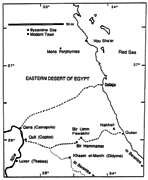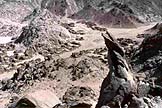
INTRODUCTION
Bir Umm Fawakhir is the first intensively studied ancient gold-mining town in Egypt, and the only one of its period in the Byzantine empire. Fawakhir is one of only two excavated Coptic/Byzantine towns (vs. monasteries) of the 5th - 6th century in Egypt, and the other, Jemê, at Medinet Habu across the Nile from Luxor, was removed to reach the New Kingdom temple. Bir Umm Fawakhir and other recently explored sites in the Eastern Desert of Egypt indicate that the Byzantine government was not too weak to control the desert, as has long been thought, but in fact continued to exploit its economic resources.
 The Bir Umm Fawakhir Project, under the direction of Carol Meyer, completed its sixth field season in January 2001. The site lies in the central Eastern Desert of Egypt about 5 km northeast of the Wadi Hammamat, or almost exactly half way between the Nile at Quft, ancient Coptos, and Quseir, ancient Myos Hormos. Bir Umm Fawakhir has now been identified as a 5th - 6th century Byzantine/Coptic gold mining town, not a Roman caravan station as it was long called.
The Bir Umm Fawakhir Project, under the direction of Carol Meyer, completed its sixth field season in January 2001. The site lies in the central Eastern Desert of Egypt about 5 km northeast of the Wadi Hammamat, or almost exactly half way between the Nile at Quft, ancient Coptos, and Quseir, ancient Myos Hormos. Bir Umm Fawakhir has now been identified as a 5th - 6th century Byzantine/Coptic gold mining town, not a Roman caravan station as it was long called.
Previous survey seasons in 1992, 1993, 1996, and 1997 mapped in detail all 237 buildings in the main settlement, which had a population estimated at a little over 1000, far larger than any modern settlement in the area. The houses of the main settlement are laid out on either side of a long narrow wadi whose sandy bottom serves as the main street. The typical house unit consists of two or three rooms, though several such units may be joined together in larger agglomerated houses of as much as twenty-two rooms. Preservation is generally quite good; many walls stand a meter or more in height and built-in features such as benches and wall niches can be detected. Scattered around the houses are a number of one-room outbuildings of uncertain function. Some house units appear to be grouped around alleys or the "plaza", but there is no sign of central planning, and to date no large administrative buildings, fortifications, or churches have been noted.
In addition, the project has identified fourteen outlying clusters of ruins of the same date, ancient roads and paths, wells, cemeteries, guardposts, granite quarries, and above all ancient mines; many of these features can be difficult to detect archaeologically. Given the almost total lack of textual evidence from or about the ancient site, pottery studies provided the 5th - 6th century site date, and since the main settlement of Bir Umm Fawakhir is essentially one period only, the pottery corpus can help those untangling the dating and stratigraphy of longer-lived and more disturbed sites. Studies of Byzantine history and of the geology of the vicinity suggest reasons why this site existed here, at this time. The Byzantine empire in these centuries faced urgent demands for gold for a multitude of purposes: wars, the navy, improving the loyalty of dubious allies, ransoming hostages, the court itself, and major building projects from Ravenna in Italy to Hagia Sophia in Constantinople to St. Catherine's on Sinai. Thus, at this time it must have been worth working these remote mines, though never since. Experiments with ancient mining and ore reduction techniques show that these low-grade, difficult-to-smelt sulfides in quartz veins in Precambrian granite, required a very sophisticated, multi-stage reduction, smelting, and purification technology. Judging from present evidence, the workers were career miners, not slaves or prisoners,and the operations were most likely under government direction. It is difficult to see who else could have recruited the workers and reliably supported them in so remote a region.
 The 1999 season was the first opportunity to excavate. Two houses, two trash heaps and one outbuilding were sampled. Building 93 was selected as being an unlooted but otherwise utterly ordinary house, but it yielded a surprising array of finds: an iron ladle, built-in potstands and bins, half a gold-copper bracelet, emeralds, some tiny coins, a Bes amulet, an intact, upside-down pot on a lower floor, beads, and a carnelian gem. Fill in the house was expected to be only 20 - 30 centimeters deep, but instead the wadi-side rooms were much deeper and had at least two distinct floor levels and two occupations. Two trash heaps north and south of Building 93 were sampled, but instead of the expected half meter or so of debris, both turned out to be kitchen areas with circular tabuns or ovens. The northern dump had three tabuns, and then a lower level with some large stones and a fire place, and then below that another floor with intact pots resting on a packed silt floor. The large-mouth pot may have been for milk and the other, pierced with five holes, may have been for making cheese. Building 177, selected because of its special location high on a granite knob turned out to have a much simpler occupation history, only one floor level, and bedrock almost immediately below the surface in most places. However, it too yielded more emeralds, beads, pendants, coins, a copper-bronze weight, and fragments of two items that look like incense burners but have no signs of burning. Many more wine dockets very cursively scrawled on the shoulders of amphoras were recovered, but no ostraca, and to date no written material at all apart from the dockets. The 2001 study season in Quft completed the documentation of the finds from the excavations and carried out a study of the plant and animal remains. The most surprising finding was the large number of cattle bones versus sheep and goats; cattle are a luxury in the desert, so it seems that the workmen were generously provisioned.
The 1999 season was the first opportunity to excavate. Two houses, two trash heaps and one outbuilding were sampled. Building 93 was selected as being an unlooted but otherwise utterly ordinary house, but it yielded a surprising array of finds: an iron ladle, built-in potstands and bins, half a gold-copper bracelet, emeralds, some tiny coins, a Bes amulet, an intact, upside-down pot on a lower floor, beads, and a carnelian gem. Fill in the house was expected to be only 20 - 30 centimeters deep, but instead the wadi-side rooms were much deeper and had at least two distinct floor levels and two occupations. Two trash heaps north and south of Building 93 were sampled, but instead of the expected half meter or so of debris, both turned out to be kitchen areas with circular tabuns or ovens. The northern dump had three tabuns, and then a lower level with some large stones and a fire place, and then below that another floor with intact pots resting on a packed silt floor. The large-mouth pot may have been for milk and the other, pierced with five holes, may have been for making cheese. Building 177, selected because of its special location high on a granite knob turned out to have a much simpler occupation history, only one floor level, and bedrock almost immediately below the surface in most places. However, it too yielded more emeralds, beads, pendants, coins, a copper-bronze weight, and fragments of two items that look like incense burners but have no signs of burning. Many more wine dockets very cursively scrawled on the shoulders of amphoras were recovered, but no ostraca, and to date no written material at all apart from the dockets. The 2001 study season in Quft completed the documentation of the finds from the excavations and carried out a study of the plant and animal remains. The most surprising finding was the large number of cattle bones versus sheep and goats; cattle are a luxury in the desert, so it seems that the workmen were generously provisioned.
 Although efforts have centered on the Byzantine/Coptic town, there are earlier remains in the vicinity. The Roman road passes immediately north, there are some sherds and faience bits, a cave near the tea houses has 1st–3rd century graffiti, and the granite quarries are believed to be Roman. Until destroyed by modern activity, there was a small Ptolemy III temple to Min, probably within what is now the modern settlement. About four km south in the Wadi el-Sid where the modern mines are, evidence of New Kingdom mining has been found as well.
Although efforts have centered on the Byzantine/Coptic town, there are earlier remains in the vicinity. The Roman road passes immediately north, there are some sherds and faience bits, a cave near the tea houses has 1st–3rd century graffiti, and the granite quarries are believed to be Roman. Until destroyed by modern activity, there was a small Ptolemy III temple to Min, probably within what is now the modern settlement. About four km south in the Wadi el-Sid where the modern mines are, evidence of New Kingdom mining has been found as well.
Publications
- "The Bir Umm Fawakhir Survey Project." The Oriental Institute Annual Report 1991-1992.
- "The Bir Umm Fawakhir Survey Project." The Oriental Institute Annual Report 1992-1993.
- "Two Weeks In The Egyptian Desert: The Bir Umm Fawakhir Project, January 1992" The Oriental Institute News & Notes, No. 136 Winter 1992.
- "Bir Umm Fawakhir: 1993 Survey Project" The Oriental Institute News & Notes, No. 138 Summer 1993.
- Meyer, Carol; Lisa Heidorn; Walter Kaegi; and Terry Wilfong. A Byzantine Gold-Mining Town: The Bir Umm Fawakhir Survey Project 1993. Oriental Institute Communications 28. 2000.
- "Gold, Granite, and Water: The Bir Umm Fawakhir Survey Project 1992." Annual of the American Schools of Oriental Research. 1995.
- "A Byzantine Gold-mining Town in the Eastern Desert of Egypt: Bir Umm Fawakhir 1992-1993." Journal of Roman Archaeology. 1995.
- "The Bir Umm Fawakhir Survey Project." The Oriental Institute Annual Report. 1995-1996.
- "Bir Umm Fawakhir." The Oriental Institute Annual Report. 1997-1998.
- "Gold Miners and Mining at Bir Umm Fawakhir." In Social Approaches to an Industrial Past: The Archaeology and Anthropology of Mining, ed. A. Bernard Knapp, Vincent Pigott, and Eugenia Herbert. 1998.
- Meyer, Carol and Lisa Heidorn. "Three Seasons at Bir Umm Fawakhir in the Central Eastern Desert." In Life on the Fringe, ed. Olaf E. Kaper. 1998.
- "Bir Umm Fawakhir." The Oriental Institute Annual Report. 1998-1999.
- "Bir Umm Fawakhir." The Oriental Institute Annual Report 2000-2001.
- Meyer, Carol; Bryan Earl; Mohamed Omar; and Robert Smither. "Ancient Gold Extraction at Bir Umm Fawakhir." In Journal of the American Research Center in Egypt 40. 2003.
- Meyer, Carol, with contributions by Lisa A. Heidorn, Alexandra A. O'Brien, and Clemens Reichel. Bir Umm Fawakhir, Volume 2: Report on the 1996-1997 Survey Seasons. Oriental Institute Communications 30. 2011.
- Meyer, Carol, with contributions by Lisa A. Heidorn, Salima Ikram, Richard L. Jaeschke, Thomas Roby, and Wendy Smith. Bir Umm Fawakhir 3: Excavations 1999-2001. Oriental Institute Publications 141. 2014.

